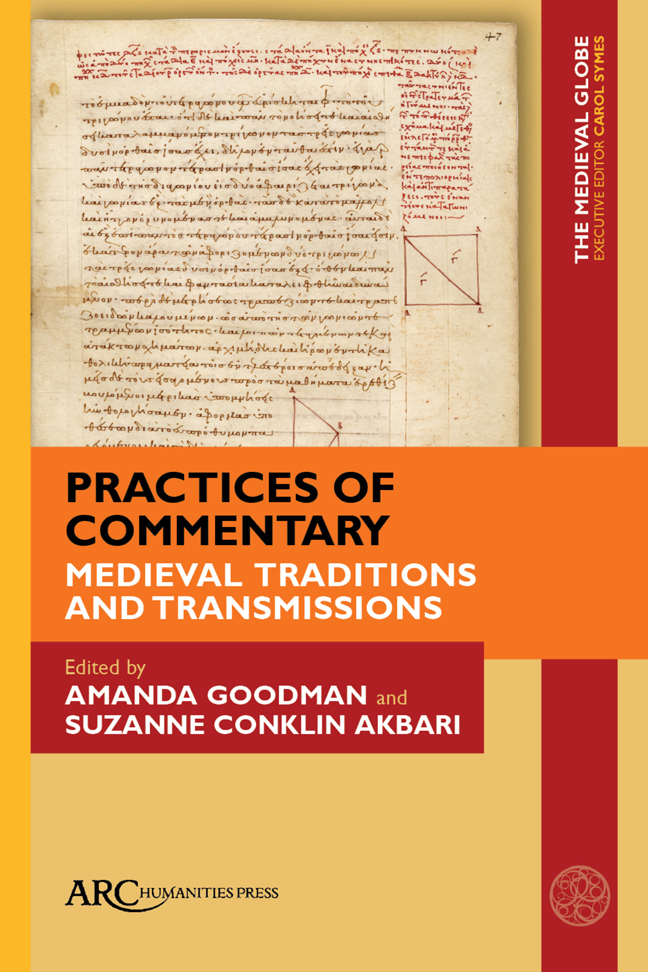Book contents
- Frontmatter
- Contents
- List of Illustrations
- Introduction: Commentary at the Crossroads
- Graeco-Roman Commentary Beyond Alexandria: Problems and Prospects
- From Plane to Space: The Narrative Arc of a Byzantine Mathematical Manual
- Periodization in the Sunni Qur'an Commentary Tradition: A Chronological History of a Genre
- On the Practice of Autocommentary in Sanskrit Sources
- Oral Commentaries and Scholarly Debates in Sanskrit Philosophy
- On the Nature of Chinese Buddhist Scriptural Exegesis: Observations on the Commentaries of Chengguan, Woncheuk, and Other Sui-Tang Exegetes
- The Mise-En-Page of a Sino-Tibetan Dunhuang Manuscript: Yuanhui's Commentary on the Laṅkāvatārasūtra
- Commentary and Multilingualism in the Ottoman Reception of Texts: Three Perspectives
- Index
From Plane to Space: The Narrative Arc of a Byzantine Mathematical Manual
Published online by Cambridge University Press: 17 February 2024
- Frontmatter
- Contents
- List of Illustrations
- Introduction: Commentary at the Crossroads
- Graeco-Roman Commentary Beyond Alexandria: Problems and Prospects
- From Plane to Space: The Narrative Arc of a Byzantine Mathematical Manual
- Periodization in the Sunni Qur'an Commentary Tradition: A Chronological History of a Genre
- On the Practice of Autocommentary in Sanskrit Sources
- Oral Commentaries and Scholarly Debates in Sanskrit Philosophy
- On the Nature of Chinese Buddhist Scriptural Exegesis: Observations on the Commentaries of Chengguan, Woncheuk, and Other Sui-Tang Exegetes
- The Mise-En-Page of a Sino-Tibetan Dunhuang Manuscript: Yuanhui's Commentary on the Laṅkāvatārasūtra
- Commentary and Multilingualism in the Ottoman Reception of Texts: Three Perspectives
- Index
Summary
THE PARANGELMATA POLIORCETICA (or Instructions for Siegecraft) is a mid- tenth-century treatise on how to lay siege to enemy cities and how to defend from such attacks. The text was composed for high-ranking military officials in the Eastern Roman (Byzantine) Empire, most likely during the reign of Romanos I Lekapenos (r. 920–944) and Constantine VII Porphyrogennetos (r. 913–959). The Poliorcetica surveys, excerpts, and glosses a host of ancient and late-antique texts on siegecraft, artillery, and other military technologies with the aim of translating this material into a more succinct and comprehensible format, also updated in response to contemporaneous Byzantine practices and newly developed technologies. At the end of the treatise, there is a short manual on mathematical calculations, known as the Geodesia. While both texts date to the mid-tenth century, the extant archetype of their manuscript tradition is found in an eleventh-century copy, now in the Vatican Library, which features extensive illustrations of the siege machines and concepts elucidated in the text.
In their stated methodology, the anonymous author of both texts demonstrates an intent to make obtuse military and mathematical principles accessible, representing them here with more simplified and clear language than the ancients and ensuring their legibility to most readers without expert knowledge. A critical aspect of this accessibil-ity is the manuscript's extensive use of illustrative images that are meant to readily com-municate the most inscrutable aspects of these technologies. For the Poliorcetica, this largely means that the images are three-dimensional representations of the weaponry described, rather than the diagrammatic line drawings of similar ancient texts, which took a more schematic approach to the representation of machinery.
While the same impetus is found in the text of the Geodesia, the difficulty of depicting geometrical models and mathematical calculations presents a fascinating challenge to the text's author and illustrator. One critical aspect to keep in mind is that the Geodesia is hardly a standalone treatise, but is instead meant to serve as an appendix to the Polior-cetica: the text presents itself as an explanatory tool to better articulate its concepts and surveying practices. Specifically, in this context, the Geodesia serves as a user's guide for a dioptra, a surveying device akin to a modern surveyor's theodolite.
- Type
- Chapter
- Information
- Practices of CommentaryMedieval Traditions and Transmissions, pp. 29 - 48Publisher: Amsterdam University PressPrint publication year: 2023

